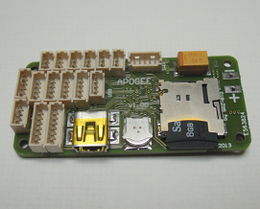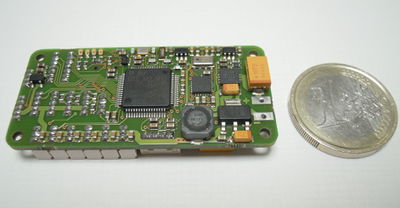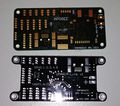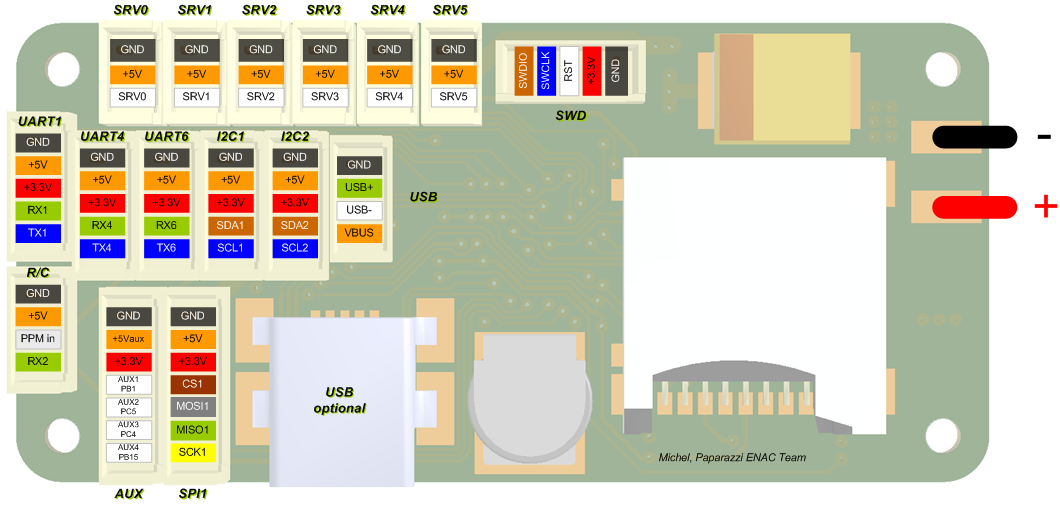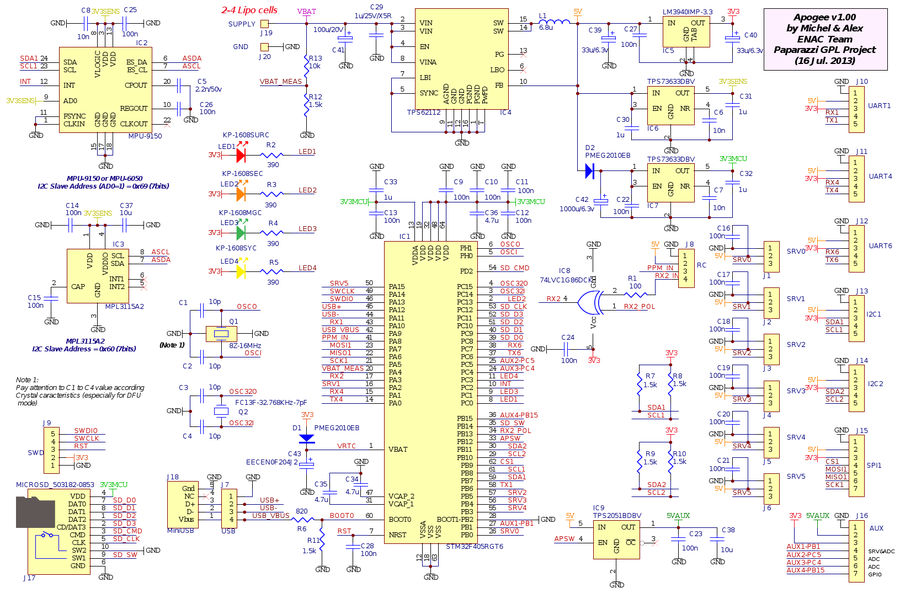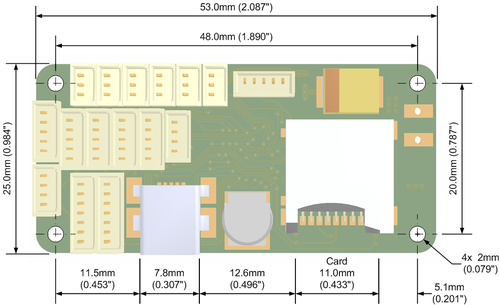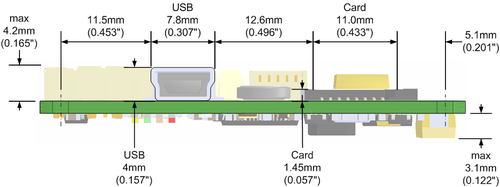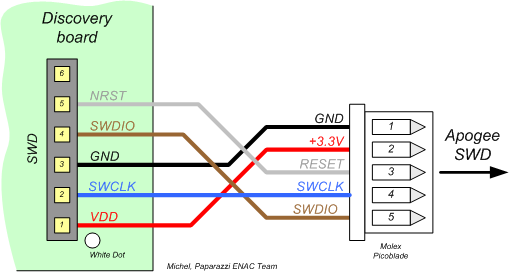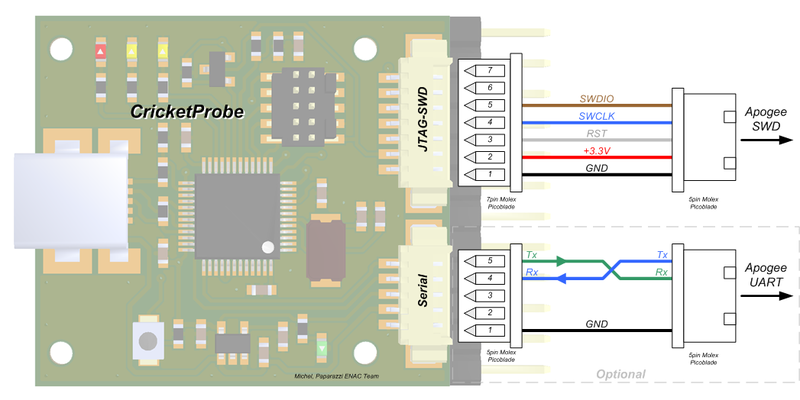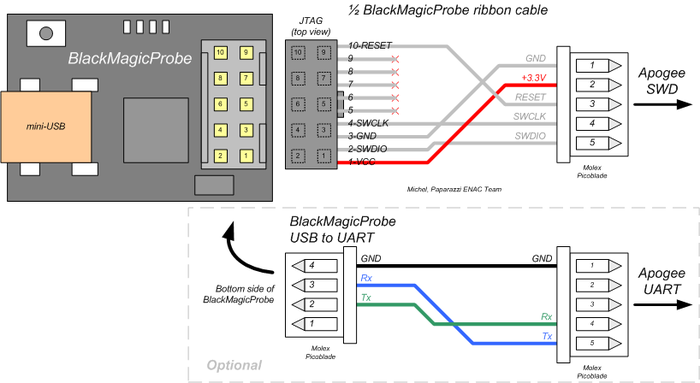Difference between revisions of "Apogee/v1.00"
(spektrum bind pin) |
(spektrum bind pin has been moved to PB15) |
||
| Line 118: | Line 118: | ||
|2||style="background:Orange; color:white"|+5v||PWR||5V Rail from autopilot | |2||style="background:Orange; color:white"|+5v||PWR||5V Rail from autopilot | ||
|- | |- | ||
|3||style="background:white; color:black"|PPM in||IN||PPM Stream from R/C Receiver (5V tolerant | |3||style="background:white; color:black"|PPM in||IN||PPM Stream from R/C Receiver (5V tolerant) | ||
|- | |- | ||
|4||style="background:green; color:white"|RX2||IN||UART2 Serial Input (5V Tolerant) through [[#R/C Serial|controlled inverter]] | |4||style="background:green; color:white"|RX2||IN||UART2 Serial Input (5V Tolerant) through [[#R/C Serial|controlled inverter]] | ||
| Line 207: | Line 207: | ||
|6||AUX3||I/O||PC4||General Purpose I/O #3 or ADC_3 Input | |6||AUX3||I/O||PC4||General Purpose I/O #3 or ADC_3 Input | ||
|- | |- | ||
|7||AUX4||I/O||PB15||General Purpose I/O #4 | |7||AUX4||I/O||PB15||General Purpose I/O #4 (also spektrum bind pin) | ||
|} | |} | ||
Revision as of 14:35, 29 May 2014
Overview
- STMicroelectronics STM32F405RGT6 Cortex M4 168MHz processor featuring a Floating point unit (FPU), up to 192k of RAM and 1024k of FLASH.
- 9(6) DOF integrated IMU MPU-9150(6050) based
- 1 x Barometer/altimeter MPL3115A2 (I2C, MPU slave capability)
- 1 x MicroSD card slot, 4 bit SDIO interface (high speed data logging)
- 1 x USB : DFU mode (download) or USB storage (direct access to MicroSD card)
- 6 x Servo PWM outputs
- 1 x R/C receiver PPM frame input
- 1 x R/C receiver serial input with inverter (Futaba S.BUS, Spektrum, etc.)
- 3 x UART
- 2 x I2C bus
- 1 x SPI bus
- RTC with backup capacitor
- SWD(ARM download/debug interface)
- 4 x Auxiliary I/O (General Purpose and/or ADC and/or servo PWM)
- 5v / 1.5A switching power supply (input voltage range 5.5V min → 17.0v max)
- 3.3v / 1A linear regulator
- 1 x 5v / 500mA power switch
- 4 x status LEDs
- 10.4 grams (0.37 oz)
- 53 x 25mm (2.1" x 0.98"), shares the same external dimensions and mounting points as UmarimLite
- 4 layers PCB design
Hardware Revision History
| Version # | Release Date | Release Notes |
|---|---|---|
| v1.00 | 07/2013 | Initial release of Apogee |
Detailed Features
SDIO (MicroSD card)
- available in latest master (v5.1_devel-780-g6ff0fc9)
- hi-cap power designed to give enough time to cleanly save buffer and close file(s) when power outage detected
- USB-storage mode when plugging an USB cable after startup
6 or 9 DOF IMU
Apogee v1.00 PCB offer two Invensense IMU chip options:
- MPU-6050 : 6 DOF, 3 axis Accelerometer + 3 axis Gyroscope
- MPU-9150 : 9 DOF, 3 axis Accelerometer + 3 axis Gyroscope + 3 axis Magnetometer
USB Modes
- usb plugged before autopilot is powered : enter DFU mode to be flashed
- usb plugged after autopilot is powered : stop ap task, enter usb storage mode to made sdcard content easily avalaible, after the host has mounted;copied;dismounted storage;unplugged usb, ap restart
SWD: Serial Wire Debug
permits flash and source level debugging via swd part of cheap discovery card, or via more capable, fastest, more expensive probe like black magic probe
R/C Serial
In addition to the classic PPM input, that mostly require receiver modification, one pin of the R/C connector is routed to the MCU UART2 receive input through a controlled inverter.
This new feature allow direct connection (3 pin) of several brand off-the-shelf receivers without hardware modification or external encoder board.
- RX2_POL(PB13) = 0 => R/C serial (Rx2) is non-inverted : allow use standard polarity serial receivers (Spektrum, FlyElectric...)
- RX2_POL(PB13) = 1 => R/C serial (Rx2) is inverted : allow use of S.BUS protocol compatible receivers (Futaba, FrSky,...)
(see R/C Receivers and Radios page for serial compatible receiver)
Real Time Clock
supercap powered rtc, permit to associate correct time and date on sdcard log files, when ap is unpowered between flights
Power Switch
5V power output pin on AUX connector ("5Vaux",#2) can be switched ON and OFF on demand using APSW (MCU GPIO output PB12).
- APSW = 0 => 5V Aux OFF
- APSW = 1 => 5V Aux ON (default)
The internal switch TPS2051B is designed to withstand 500mA continuous current and is short-circuit and thermally protected.
(see TPS2051B datasheet for recommended operation conditions)
Pictures
Pinout
Pins Name and Type are specified with respect to the Autopilot Board
| Pin # | Name | Type | Description |
|---|---|---|---|
| 1 | GND | PWR | common ground |
| 2 | +5V | PWR | 5V Rail from autopilot |
| 3 | SRVx | OUT | Servo signal (PWM) |
| Pin # | Name | Type | Description |
|---|---|---|---|
| 1 | GND | PWR | common ground |
| 2 | +5v | PWR | 5V Rail from autopilot |
| 3 | PPM in | IN | PPM Stream from R/C Receiver (5V tolerant) |
| 4 | RX2 | IN | UART2 Serial Input (5V Tolerant) through controlled inverter |
| Pin # | Name | Type | Description |
|---|---|---|---|
| 1 | GND | PWR | common ground |
| 2 | +5V | PWR | 5V Rail from autopilot |
| 3 | +3.3V | PWR | 3.3V Rail from autopilot |
| 4 | RX1/4/6 | IN | UART1/4/6 Serial Input (3.3V level, 5V Tolerant) |
| 5 | TX1/4/6 | OUT | UART1/4/6 Serial Output (3.3V level) |
| Pin # | Name | Type | Description |
|---|---|---|---|
| 1 | GND | PWR | common ground |
| 2 | +5V | PWR | 5V Rail from autopilot |
| 3 | +3.3V | PWR | 3.3V Rail from autopilot |
| 4 | SDA1/2 | Open Drain I/O (1.5k pull-up) |
I2C1/2 bus Serial DAta |
| 5 | SCL1/2 | Open Drain I/O (1.5k pull-up) |
I2C1/2 bus Serial CLock |
| Pin # | Name | Type | Description |
|---|---|---|---|
| 1 | GND | PWR | common ground |
| 2 | USB+ | I/O | USB bidirectional D+ line |
| 3 | USB- | I/O | USB bidirectional D- line |
| 4 | VBUS | IN | Indicates the presence of USB bus power (5V level), DFU or USB storage Mode selection |
Note: MiniUSB and Molex USB connectors are in parallel, only one can be connected at a time.
| Pin # | Name | Type | Description |
|---|---|---|---|
| 1 | GND | PWR | common ground |
| 2 | +5V | PWR | 5V Rail from autopilot |
| 3 | +3.3V | PWR | 3.3V Rail from autopilot |
| 4 | CS1 | OUT | Slave Select. Selects the SPI slave (PB9) |
| 5 | MOSI1 | I/O | SPI1 Master Out Slave In. Data output from master / data input to slave |
| 6 | MISO1 | I/O | SPI1 Master In Slave Out. Data input to master / data output from slave |
| 7 | SCK1 | I/O | SPI1 Serial clock. Clock output from master or input to slave |
| Pin # | Name | Type | Port | Description |
|---|---|---|---|---|
| 1 | GND | PWR | common ground | |
| 2 | +5Vaux | PWR | 5V from autopilot through Power Switch | |
| 3 | +3.3V | PWR | 3.3V Rail from autopilot | |
| 4 | AUX1 | I/O | PB1 | General Purpose I/O #1 or ADC_1 Input or PWM6 |
| 5 | AUX2 | I/O | PC5 | General Purpose I/O #2 or ADC_2 Input |
| 6 | AUX3 | I/O | PC4 | General Purpose I/O #3 or ADC_3 Input |
| 7 | AUX4 | I/O | PB15 | General Purpose I/O #4 (also spektrum bind pin) |
| Pin # | Name | Type | Description |
|---|---|---|---|
| 1 | GND | PWR | common ground |
| 2 | +3.3V | PWR | 3.3V Rail from autopilot |
| 3 | RST | IN | MCU Reset |
| 4 | SWCLK | IN | Serial Wire Clock |
| 5 | SWDIO | I/O | Serial Wire Data Input/Output |
Schematic
PCB
Gerber & Drill Files
PCB design Eurocircuits 6-C class compliant:
Download Apogee v1.00 gerber & drill files (zip)
RS274X, units = Inches, format = 2:5
- Apogee_v100_Silkscreen_TOP.GBR (Top Component Print Layer)
- Apogee_v100_Soldermask_Top.GBR (Top Solder Mask)
- Apogee_v100_Paste_Mask_Top.GBR (Top Paste Mask, stencil)
- Apogee_v100_Signal_Top.GBR (Top Copper Layer)
- Apogee_v100_Internal_Plane_1.GBR (Internal Copper Layer GND)
- Apogee_v100_Internal_Plane_2.GBR (Internal Copper Layer +3.3V)
- Apogee_v100_Signal_Bottom.GBR (Bottom Copper Layer)
- Apogee_v100_Paste_Mask_Bottom.GBR (Bottom Paste, stencil)
- Apogee_v100_Soldermask_Bottom.GBR (Bottom Solder Mask)
- Apogee_v100_Outline.GBR (Board Outline)
- Apogee_v100_Drill.GBR (NC XY coordinates & Drill tools sizes)
Assembly
Components Layout
Bill Of Material
Download Apogee v1.00 Bill of Material (zipped .xls file)
PCB and assembled boards suppliers
Check availability on Get Hardware page
Mechanical Dimensions
Programming
Apogee autopilot can reprogrammed in two different ways:
- using the MCU native (embedded in rom) DFU USB bootloader over the on-board USB header (so pre-loading an "external" bootloader is useless)
- required hardware : usb cable with usb-mini connector
- required software : dfu_util tool (present in ubuntu repository)
- using the SWD (Serial Wire Debug) connector
- required hardware : usb cable with usb-mini connector, molex to 2.54mm pitch pin cable, swd part of a cheap stm32 evaluation board (any discovery board, start @ 8$)
- required software : st_flash and st_util, have to be compiled from source (https://github.com/texane/stlink)
Debugging
Debugging with STM Discovery ST-LINK/V2 embedded debug tool
Debugging with CricketProbe
Debugging with Black Magic Probe
Source Files
Apogee v1.00 hardware design (zipped Protel99SE SP6 database file)
Source code
Available in latest git master branch
